
IUSS News
The European Law on Soil Monitoring
Edoardo A.C. Costantni
President of the International Union of Soil Sciences
On July 5, 2023, the European Commission published the Proposal for a Directive of the European Parliament and of the Council on soil monitoring and resilience (Soil Monitoring Law) COM(2023) 416 final 2023/0232 (COD).
Background: In April 2002, the Commission announced its intention to develop a Soil Protection Strategy and prepare the ground for a European soil legislation proposal. Subsequently, in 2006, the Commission adopted an initial proposal, but heated political debates took place in the EU Council under different presidencies. Ultimately, an agreement was not reached due to a minority of five Member States. As a result, the Commission withdrew its proposal in 2014. Meanwhile, soil degradation in Europe has worsened. Currently, 4.2% of the territory has been urbanized, mainly at the expense of agricultural land. Furthermore, soil degradation is compromising the long-term fertility of agricultural land. It is estimated that between 61% and 73% of agricultural land in the EU is affected by erosion, organic carbon loss, nutrient excesses (primarily nitrogen and phosphorus), compaction, or secondary salinization (or a combination of these threats). All of this causes serious environmental and economic damage. The Commission estimates that soil compaction alone can reduce crop yields by 2.5% to 15%. Additionally, over one billion tons of soil are lost annually due to erosion. Without sustainable soil management and actions to regenerate soils, it is feared that compromised soil health will become a central factor in future food security crises. Contaminated soils also affect food security. For example, around 21% of agricultural soils in the EU contain concentrations of cadmium in the topsoil that exceed the established limit for groundwater.
The European Commission believes that collective action is necessary, also because soil degradation costs the EU a total of around 74 billion euros per year. The directive falls within the framework of the European Green Deal and contributes to achieving the ambitions set by the EU Soil Strategy for 2030. The EU Soil Strategy is a key outcome of the EU Biodiversity Strategy for 2030 and establishes a framework and concrete measures to protect and restore soils and ensure their sustainable use. It also sets a vision and objectives to achieve healthy soils by 2050, with concrete actions by 2030. The aim of the proposed Directive is to contribute to addressing major social challenges, such as:
– Achieving climate neutrality and becoming resilient to climate change
– Reversing biodiversity loss and fulfilling international commitments on biodiversity
– Reducing pollution to levels no longer considered harmful to human health and the environment
– Fulfilling international commitments on neutrality in soil degradation
Specifically, the implementation of the proposal should ensure that soils throughout the EU are healthy by 2050 and managed sustainably to avoid further deterioration. The objective of this Directive proposal is to stop soil degradation, thereby ensuring that soils can provide multiple ecosystem services to meet environmental, social, and economic needs, while reducing soil pollution to levels no longer considered harmful to human health and the environment.
The operational objectives, on the other hand, are to establish measures to stop soil degradation and regenerate soil health, provide an effective framework for ensuring the implementation of the Directive, particularly through the obligation for Member States to assess soil health.
The directive establishes measures related to soil monitoring and evaluation; sustainable soil management; inventory and remediation of contaminated sites.
It is useful to remember that the Directive defines ‘soil’ as the top layer of the Earth’s crust situated between the bedrock and the land surface, which is composed of mineral particles, organic matter, water, air and living organisms; while ‘soil health’ means the physical, chemical and biological condition of the soil determining its capacity to function as a vital living system and to provide ecosystem services.
The main activities that Member States will have to carry out are as follows:
(1) Defining soil health and establishing territorial soil districts, delineated based on soil type, climatic conditions, environmental zone, land use or land cover.
(2) Soil health monitoring: Member States will have to establish a monitoring framework based on soil districts. The monitoring framework will be based on soil health descriptors and criteria. A soil is considered healthy when the values of all soil descriptors meet the established criteria.
(3) Sustainable soil management: Member States will need to define sustainable soil management practices to be gradually implemented on all soils, as well as the practices that negatively impact soil health, which have to be avoided. Based on the outcome of soil health assessments, they will also need to establish regeneration practices to be gradually implemented on unhealthy soils. Member States should establish mechanisms to recognize the efforts of landowners and soil managers in maintaining soil in healthy conditions, including soil health certification.
Regarding the reduction of soil consumption, Member States must avoid or minimize the loss of soil’s capacity to provide ecosystem services, including food production, by reducing the area affected by urbanization, selecting areas where the loss of ecosystem services can be minimized, and implementing urbanization in a way that minimizes negative impacts on the soil. Member States must also compensate as much as possible for the loss of soil’s capacity to provide ecosystem services caused by urbanization through appropriate interventions.
(4) Identification, registration, investigation, and assessment of contaminated sites.
(5) Restoration (regeneration) of soil health and remediation of contaminated sites.
The selected soil descriptors for assessing soil health play a crucial role in the implementation of the directive. Each descriptor has a threshold indicating the soil’s health status. The descriptors common across the EU are salinization, erosion, organic carbon, and subsoil compaction. At the Member State level, the descriptors are nutrient content, contamination, and water retention capacity. Other descriptors without threshold criteria are acidification, surface soil compaction, biodiversity, and urbanization.
The water retention capacity descriptor is particularly interesting and innovative. The estimated value for the total water retention capacity of a soil district should exceed a minimum threshold per hydrographic basin or sub-basin. The minimum threshold will be determined by the Member State at the soil district and hydrographic basin or sub-basin level to mitigate the impacts of periods of drought and of flooding due to heavy rainfall. Actually, healthy soils can retain up to 25% of their mass in water, contributing to the prevention of disaster risks and acting as long-term reservoirs for recharging groundwater. The natural water storage capacity of resilient soils, wetlands, and forests exceeds what could be achieved through costly new artificial reservoirs.
The criteria used to assess soil health are also interesting, although they may not fit well with Mediterranean conditions. The carbon/clay ratio > 1/13 is too high for Mediterranean soils, which are often clay-rich. However, in this case, Member States can adjust the threshold based on their conditions. Adjustment is not provided, though, for soil erosion, where the threshold between healthy and unhealthy soils is set at >2 tons/ha/year. This means that most Mediterranean soils cultivated even on gentle slopes are considered unhealthy. However, the criterion does not consider soil erosion caused by land leveling, slope modeling, and earth movements, which are activities responsible for significant soil losses, especially prior to planting tree crops.
The Commission expects that the proposed Directive will bring significant environmental benefits and improve soil health, with positive effects on water and air quality, biodiversity, climate, and food benefits.
It is also expected that the implementation of the proposal will create numerous opportunities for SMEs in terms of growth (e.g., investigation and remediation of contaminated sites, soil health consulting services, soil analysis laboratories) and innovation in designing and implementing sustainable soil management and restoration measures. Furthermore, the implementation of soil monitoring should create opportunities for research and development in companies providing soil surveys.
The directive includes some indicators to monitor its implementation:
– Number of soil health monitoring points.
– Proportion of EU territory where soils are in good health.
– Measures of sustainable soil management adopted.
– Measures of regeneration implemented.
– Number of potentially contaminated sites registered in dedicated national registers.
– Number of potentially contaminated sites investigated.
– Number of contaminated sites remediated or properly managed.
The proposed directive will enter into force after its adoption, but there will be a 2-year transition period for Member States to adopt and notify the laws, regulations, and administrative provisions necessary to comply with this directive. After the end of the transition period, Member States must establish adequate governance and a soil monitoring framework, including the determination of sampling points and the adoption of methodologies to establish soil districts and establish a register of potentially contaminated sites. It is also expected that coordinated action at the EU level will address potential distortions in the internal market and unfair competition among businesses, as some Member States have less stringent environmental requirements.
However, the directive allows Member States considerable flexibility to identify the most appropriate measures and adapt the approach to local conditions. This is considered crucial to ensure that regional and local specificities in terms of soil variability, land use, climatic conditions, and socio-economic aspects can be adequately considered.
The estimated private costs of implementing sustainable management and restoration of agricultural and forest soil range from 28 to 38 billion euros per year. It is also estimated that 29 billion euros (distributed over 15 years) will be required for identifying and investigating contaminated sites, and 24.9 billion euros (distributed over 25 years) for remediation of contaminated sites.
Overall, the annual benefit derived from the costs avoided due to soil degradation is estimated at 550 billion euros, excluding contamination, which has an estimated benefit of 220 billion euros per year. During the evaluation period until 2060, the Commission calculates a public and private benefits-to-cost ratio of 1.7 for the implementation of the directive.
Beyond these positive and significant economic estimates, the Directive has the indisputable merit of drawing the attention of policymakers and public administrators to soil health, upon which the health of European citizens also depends. It represents a historical step forward in achieving public awareness of soil health, and it is certainly hoped that it will be approved by the European Parliament.
The soil science community is immensely grateful to all those who have worked tirelessly for many years to achieve this significant outcome. We also acknowledge the contributions of soil scientists from all over the world, who have helped establish the knowledge foundation for this directive.
The directive remains open to adjustments, which can be based on the results of its application. Therefore, a further significant contribution from soil scientists will be needed in the coming years.
The Technical University of Munich (TUM) invites applications for the position of Professor in » Soil Systems Science « W2 Tenure Track Assistant Professor (with tenure track to W3) or W3 Associate/Full Professor; to begin as soon as possible.
Scientific environment: The professorship will be assigned to the TUM School of Life Sciences, located at the interdisciplinary campus Freising-Weihenstephan.
Responsibilities: The responsibilities include research and teaching as well as the promotion of early-career scientists. We seek to
appoint an expert in the research area of soil systems with a focus on the development of sustainable land use strategies, e.g., with respect to soil carbon and nutrient storage, in an agricultural, forestry and/or urban context. Teaching responsibilities include courses in the university’s bachelor and master programs, specifically in the areas of forestry and resource management and agricultural sciences.
Please send your application no later than 18th October 2023 to the Dean of the TUM School of Life Sciences, Prof. Ingrid Kögel-Knabner, via our recruitment portal: www.recruit.tum.de
IUSS Centennial 2024
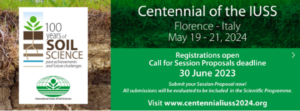
Centennial Celebration and Congress of the IUSS 100 years of soil science – past achievements and future challenges
Invitation from the organizers: Sara Marinari, Giuseppe Corti, Edoardo A.C. Costantini
“The custodian of soil science will celebrate its centennial contribute to the nature and human wellbeing in 2024.
The event will also empower the linkages with different disciplines, policy makers, stakeholders, institutions, and associations to effectively address civil society needs within agriculture, forestry, environment, urban planning, energy, education, and other societal issues.
The celebration will occur on May 19th and will be followed by two intense days of congress, with plenary and parallel scientific sessions. Both soil scientists and specialists from other disciplines will participate to each session, focusing on past achievements and future challenges.
The congress will be followed by technical/scientific excursions that will range from short local to long trips, spanning from Alps to Sicily.
A pre-congress visit to Villa Lubin in Rome, the historical place where the IUSS was founded, is scheduled on May 18th.
We are looking forward to welcoming you to Italy”.
Sunday, 19 May 2024 to Tuesday, 21 May 2024
Florence, Italy
Website: https://centennialiuss2024.org/
Download: media/iuss_2024_brochure.pdf
GENERAL THEMES
- Soil health in achieving the Sustainable Development Goals
- Soil governance
- Soil in the circular economy
- Soil sciences impact on basic knowledge
- Soil in the digital era
- Soil and humanity
- Equity, diversity, and inclusivity in soil sciences
- Other
The programme group chair and officers will build the session programme from the session proposals. The programme group chair may also suggest to merge proposed sessions that are similar https://centennialiuss2024.org/submitted-sessions/#1685449512773-65c24928-1e65
The call for session proposals at https://centennialiuss2024.org/ was open until 30 June 2023.
NEXT STEPS:
- 25 Sept 2023 Session Proposal: notification of acceptance/ rejection to conveners
- 16 Oct 2023 – 15 Jan 2024 Call for abstracts
- 26 Feb 2024 Abstract Submission: notification of acceptance/rejection to authors
- 11 Mar 2024 Letter of schedule
- 25 Mar 2024 Deadline for early registration
- 13 May 2024 Deadline for late registration – Online registration closing
- 19–21 May 2024 Centennial Celebration and Congress of the International Union of Soil Sciences
News from national and regional soil science societies
Soil Science Society of Poland
Soil Science Society of Poland invite you to participate in their 31st Congress to be held from 12 – 14th September 2023 in Poznań, Poland. https://soilcongress2023.up.poznan.pl/en
NEWS FROM THE Latin American Soil Science Society: SLCS
Soil Science Society of Mexico
The International Round Table for Young and Early Career Scientists will be held on October 18, 2023, in a hybrid format at the Exhibition and Congress Center of the University City, National Autonomous University of Mexico, Mexico City.
STOP SOIL DEGRADATION and the IUSS’s EDUCATIVE PROJECT TO ACHIEVE IT
Soil Science Society of Mexico
Within the framework of the 47th Mexican Congress of Soil Science, and as part of the educational projects “Thus are the Soils of my Nation” of the Latin American Society of Soil Science and “THE IUSS GOES TO SCHOOL“, the XVII Symposium on Educational Innovations in the Teaching of Soil Science will take place on October 17, 2023, at the Exhibition and Congress Center of the University City, National Autonomous University of Mexico, Mexico City.
British Society of Soil Science
Guidance Note for Land Managers Soil Carbon: What are carbon stocks and how can they be measured?
We are pleased to be able to share our new guidance note for land managers – Soil Carbon: What are carbon stocks and how can they be measured. This is the first note that we have developed as part of our new series, Land Use for Net Zero.
Upcoming Working with Soil Training Courses
If you are looking to further your knowledge about soils, why not book onto our Working with Soils training course which will encompass how soils form, why they differ, and how they are classified.
– A Practical Introduction to Soils in England and Wales. Tuesday 10 – Wednesday 11 October. Aberystwyth
We are also running an online training course which will provide a basic understanding of the principles and methodology behind soil classification.
– An Introduction to Soil Classification. Tuesday 18 – Wednesday 19 July.
Read more: https://members.soils.org.uk/event-5252160
Agricultural Land Classification Course
Bookings are now open for our Agricultural Land Classification (ALC) course https://members.soils.org.uk/event-5407996 which will take place at Cranfield University on 22 and 23 November. This in-person training course offers a unique opportunity to learn about the background and technical basis of the current ALC guidelines.
This course is designed for soil scientists who wish to extend their experience, those commissioning ALC surveys from specialists, and planners reviewing ALC reports.
Read more: https://members.soils.org.uk/event-5407996
Building a Roadmap for Soil Health
During the United Nations Climate Change Conference in Bonn last month, we were delighted to co-host a policy dialogue session with the Coalition of Action 4 Soil Health (CA4SH) and the International “4 per 1000” initiative aimed at policymakers.
The focus of the session was Building a Roadmap for Soil Health in the Climate Change Agenda. We highlighted the need for urgent intervention at a global scale, to prevent further degradation of our soils, allow us to support the ever-growing human population and to meet our climate change targets.
Read Executive Officer, Sarah Garry’s blog to find out more about the event.
https://soils.org.uk/blog/bsss-co-host-policy-session-at-sb58-bonn-climate-change-conference/
First joint ICOBTE & ICHMET Conference
September 6-10, 2023
Wuppertal, Germany
Overall aim of the first joint ICOBTE & ICHMET conference. Environmental pollution is an eminent, ever-present problem for mankind, jeopardizing the health of humans, ecosystems, and the environment. Thus, maintaining a clean environment for human health is a constantly urgent need for a global society. Under the motto “Clean Environment, Human Health, Our future”, the 1st joint ICOBTE & ICHMET 2023 conference ultimately addresses means to overcome environmental pollution and contaminant issues. This conference will bring together, from a global perspective, scientists, researchers, early career scientists, end-users, industry, policy makers, and other professionals to exchange ideas, advance knowledge and discuss key topics related to environmental pollution, with a focus on trace element and heavy metal contamination in the environment. The joint ICOBTE & ICHMET conference is a forum where world-leading scientists in the field of trace elements and heavy metals in the environment present their latest research, insights, and cutting edge technologies. Interactions occur across various disciplines, including human health issues, ecotoxicology, oceanic, atmospheric and earth science, trace element geochemistry and biogeochemistry, environmental technology and analytical chemistry.
Read more: https://nbsoil.eu/event/1st-joint-icobte-ichmet-2023-conference/
European Healthy Soils, 1st edition: Soil Fertility https://www.efbiotechnology.org/healthysoils
September 13-15, 2023
Muttenz, Switzerland
The topic Healthy Soils is a key element of the European Soil Strategy. This first edition of the European Healthy Soils Conference Series will address the relevance of healthy soils and soil fertility as prerequisite for a functioning society, environment, economy, and climate. The 3-day conference aims to bring together soil scientists, along with stakeholders from industry, agriculture, and the public sector, to discuss the maintenance of and opportunities in healthy soils. The event is co-organized by the FHNW School of Life Sciences and Agroscope, under the umbrella of the European Federation of Biotechnology divisions of Plant, Agriculture & Food and Environmental Biotechnology.
Indian Society Of Soil Science – ISSS-India
Annual Convention
The 87th Annual Convention of the Indian Society of Soil Science (ISSS) will be held at ICAR-Indian Institute of Soil Science (IISS), Bhopal – 462038, Madhya Pradesh during October 3-6, 2023 (Tuesday to Friday). The Annual Convention is open to only members of the ISSS and others are not eligible to register for the Convention.
Canadian Society of Soil Science
2023 ASA-CSSA-SSSA INTERNATIONAL ANNUAL MEETING, OCTOBER 29-NOVEMBER 1, 2023 | ST. LOUIS, MO
The Annual Meeting is one of the few gatherings that bring together thousands of scientific leaders from industry, government agencies, and academic institutions in one environment. It’s the premier opportunity for professionals working in agronomic, crop, soil, and related sciences to hear about the latest research, meet and learn from their peers, expand their knowledge base, and take advantage of networking opportunities to enhance their careers. The Societies Annual Meeting features thousands of technical presentations, along with a host of networking events and award ceremonies. The world-class exhibition displays the latest scientific equipment, supplies, services, and reference materials available. Find diverse answers to today’s environmental problems. Learn about cutting-edge research, network with peers, and advance your career all in one place. Finding Solutions – With hundreds of sessions to choose from, find exciting and innovative ways to tackle issues you’re facing in the field. Educate yourself so you can educate others. Strengthening Communities – There are numerous ways you can network, including hands-on workshops, student leadership activities, field tours, and more. Build relationships with over 3,000 colleagues from around the world. Broadening Opportunities – Expand your horizons and equip yourself with the right tools to advance your science. Develop your advocacy skills at science policy events, find your next job at the career center, and explore products at the exhibit hall. Spark your inspiration this year at the ASA, CSSA, and SSSA International Annual Meeting
Soil Science Society of South Africa
2023 Beauty of African Soils – Photo Competition
Competition details: The competition is now open, and closes on 30 November 2023. This competition is open to all SSSSA members. If you win, but are behind on membership fees, your outstanding fees will be subtracted from your cash winnings Photos (max 4 per person) can be submitted to Corrie Swanepoel at SwanepoelC@arc.agric.za
Categories:
• Soils up-close
• Soils in landscapes/agriculture
• Soil and people/animals
• Living soils (pictures about soil organisms, soil conservation, intercropping, mulch, CA, fungi)
Photo requirements: The entered photo must feature African soil prominently. The photo must have been captured by the person entering the competition. Each SSSSA member may enter up to 4 photos. High resolution photos are preferred (above 1.5 MB). Ensure that if you have permission from any persons featured in the photograph. No copyrighted photos should be submitted.
Latin American Soil Science Society
VII CONGRESS OF THE ARGENTINE SALINITY NETWORK AND THE 2ND LATIN AMERICAN SYMPOSIUM ON SALINE SOILS
Date 2023-09-18
Santa Rosa La Pampa, Argentina Congresos y eventos
Spanish Soil Science Society
XXIII NATIONAL MEETING ON SOILS-RENS 2023, from September 12 to 15 2023 in Pamplona-Iruña (Navarra). https://www.unavarra.es/reunion-nacional-suelos-2023
Soil Science Society of Mexico
XVII SYMPOSIUM ON EDUCATIONAL INNOVATIONS IN THE TEACHING OF SOIL SCIENCE to be held on October 17, 2023, at the University city exhibition and congress center of the national autonomous University of Mexico, Mexico city.
Biota, water, and humans. Management for a sustainable world
18 – 22 October 2023, Gandia, Spain
Read more: https://7biohydrology.webador.es/
5th International Conference on Sustainable Natural Resource Management Under Global Climate Change
7 – 10 November 2023, New Delhi, India
Flyer (11 MB)
Web SCSI
2023 ASA, CSSA, SSSA INTERNATIONAL ANNUAL MEETING OPEN SCIENCE INSPIRES OCTOBER 29- NOVEMBER 1 | ST. LOUIS, MISSOURI AND LIMITED VIRTUAL.
ASA, CSSA & SSSA International Annual Meetings
The American Society of Agronomy, the Crop Science Society of America, and the Soil Science Society of America jointly host the premier gathering of ideas, solutions, and innovation from across the field of environmental sciences.
OCTOBER 29- NOVEMBER 1
USA – Soil Science Society
ASA, CSSA & SSSA International Annual Meeting 2024
488 days left ASA, CSSA & SSSA International Annual Meeting Dates: 11/10/2024
Venue: San Antonio TX, San Antonio TX, United States
The American Society of Agronomy, the Crop Science Society of America, and the Soil Science Society of America host a premier international scientific meeting that brings together leading and emerging scientific leaders from industry, government agencies, and academic institutions who are all working to advance agronomic, crop and soil sciences.
(Website: https://www.acsmeetings.org/)
SSSA 2024 SUMMER CONFERENCE COMMON GROUND: SOILS BEYOND BORDERS JUNE 10-12
SAN JUAN, PUERTO RICO Home | ASA, CSSA & SSSA International Annual Meetings
The Soil Science Society of America is hosting a summer conference that provides unlimited networking opportunities, innovative scientific abstracts, poster sessions, invited symposia, exhibitors, technical workshops, and professional tours
Conferences, Meetings and Workshops
2023
31st Congress of the Soil Science Society of Poland – “Soil in a changing World”
September 11th – 16th, 2023
Poznań, Poland – Format: in-person
Registration: https://soilcongress2023.up.poznan.pl/en/registration-form Read more: https://soilcongress2023.up.poznan.pl/en
III SICA-SISS-SIPe Congress 2023
September 12th – 15th, 2023
Palermo, Italy
The Soil, the Plant, the Environment “Synergies in the Soil-Plant System for Environmental Protection and Food Safety”.
The multifunctional centrality of soil in global environmental sustainability is now widely recognized: without the fundamental interaction between soil and plants we would not have food, water, ecosystems, biodiversity.
Early Bird Registration: June 10, 2023
Late Registration: July 22, 2023
Deadline for abstract submission: June 10, 2023
Read more: Home SPA 2023
European Healthy Soils Conference Series 1st Edition, Soil Fertility
September 13th– 15th, 2023
Muttenz, Switzerland
The topic Healthy Soils is a key element of the European Soil Strategy. This first edition of the European Healthy Soils Conference Series will address the relevance of healthy soils and soil fertility as prerequisite for a functioning society, environment, economy, and climate.
Read More: European Healthy Soils (efbiotechnology.org)
10th World Sustainability Forum (WSF2023)
September 14th, 2023
Hybrid: Singapore; Basel, CH; Toronto, CA, & virtual, International
The forum is dedicated to cutting-edge mono- and interdisciplinary research on Sustainable Development, Sustainability, Sustainable Development Goals. WSF2023 is part of a series of MDPI-supported and organizational sustainability global forums.
Early Bird Registration: July 30, 2023
Late Registration: August 21, 2023
Registration deadline: September 3, 2023
Cover author registration: July 23, 2023
Read more: The 10th World Sustainability Forum (WSF2023)
XIV International symposium and field workshop on paleopedology
October 7th – 15th, 2023
Las Cruces, New Mexico State University, USA (Hybrid modality)
The symposium is a joint event of IUSS Commissions 1.6 Paleopedology, Commission 1.2 Soil Geography, and INQUA Paleopedology Working Group and New Mexico State University as a host institution. Contributions concerning any problems of soil development in time and space are accepted.
Abstract submission: May 14th to August 15th, 2023
Address: paleo.geo.NM.2023@gmail.com
Download: https://inqua.org/media/uploads/announcement%2005-05-2023.pdf
33rd CODATA General Assembly to be held
October 27th– 28th, 2023
Salzburg, Austria
Invite the CODATA Members and Task Groups to make nominations for the election of Officers and Ordinary Members of the Executive Committee
The deadline for nominations: June 27th , 2023.
By September 1st, 2023, the Nominating Committee will distribute to CODATA Members a Balanced Slate of candidates for election to the Offices of President, Vice-President(s) and ten places on the Executive Committee.
Download: https://codata.org/wp-content/uploads/2023/04/CODATA-EC-Nominations-Procedure-Document-2023.pdf
2023 IEEE INTERNATIONAL WORKSHOP ON Metrology for Agriculture and Forestry
November 6th– 8th, 2023
Pisa, Italy
MetroAgriFor intends to create an active and stimulating forum where academics, researchers and industry experts in the field of measurement and data processing techniques for Agriculture, Forestry and Food can meet and share new advances and research results.
Workshop Topics: Sensor networking and integration; Approaches and tools for measuring Food Quality; Soil analysis, mapping and monitoring; Crop analysis, mapping and monitoring;
Precision agriculture, forestry and livestock farming; Measurements for agriculture, forestry and environment; Agroclimatic measurements.
Important Dates
Paper Submission Deadline: July 15, 2023
Extended Abstract Acceptance Notification: September 1, 2023
Final Paper Submission Deadline: September 20, 2023
Read More: Index | IEEE MetroAgriFor 2023
5th International Conference “Sustainable Natural Resource Management under Global Climate Change”
November 7th– 10th, 2023
New Delhi, India
The conference aims at bringing together academicians, researchers, students, and other different stake holders from within India and abroad in the attempt to deliberate on different aspects of the subject of conservation and optimal utilization of natural resources.
The scientific event will organized by Soil Conservation Society of India, in collaborative mode with support of International Soil Conservation Organization (ISCO), World Association of Soil and Water Conservation (WASWAC), Beijing, International Union of Soil Science (IUSS), and other international and national organizations.
Submission papers: 15th April 2023
Intimation of acceptance of abstracts: 15th September 2023
Last date for registration (without late fees): 1st October 2023
Information contained in the circular and all updates are available at the website of SCSI
Read More: http://scsi.org.in
The International Scientific Conference II NIKITIN’S READINGS
November 14th-17th, 2023
Perm, Russia
«Current Issues of Soil Science, Agrochemistry and Ecology in Natural and Anthropogenic Landscapes». The conference is devoted to Vasily Vasilyevich Nikitin, the first professor of Soil Science in the Urals and the Head of the Soil Science Department (1924-1932); 100th anniversary of the first Soil Science Department in the Urals; 140th anniversary of Soil Science.
The registration deadline has been extended until May 31, 2023.
The registration link can be found on the official event’s page:
Read More: https://pgatu.ru/science/conferences/issues_soil_science_agrochem_eco/
https://pgatu.ru/sys/confproblems/en
Third EUSO Stakeholder Forum
November 20th – 24th 2023
Madrid, Spain
The 3rd EUSO Stakeholder Forum will take place in the “2023 EU Soil Week” in Madrid in the week 20-24 of November. This event brings together the annual EUSO Stakeholder Forum, the first ever Soil Mission Fair and a workshop on soils by the Spanish Presidency.
Organic phosphorus workshop 2023 (opw 2023)
November 27th – December 1st, 2023
Pucón, Chile
“Exploring organic phosphorus fate in soil and aquatic ecosystems under the climate change and food security scenario” is the fourth iteration of the organic phosphorus workshop series.
The focus the workshop concern long-term inputs of phosphorus have resulted in the accumulation of significant quantities of legacy phosphorus in agricultural soils by mineral fertilizers which in turn has contributed to increased diffuse phosphorus transfer and accelerated eutrophication of many water bodies. Biological processes play a vital role in determining the mobility and bioavailability of phosphorus in soils and sediments.
Deadline for abstract submission: June 30, 2023
Abstract acceptance: July 15
Notification of authors: August 31
Final announcement: before October 31.
Read more: OPW 2023 | Organic Phosphorus Workshop 2023 (opwinchile2023.cl)
International symposium Reading the soil in archaeology: field practice and interdisciplinary perspectives
November 29th – December 1st, 2023
Tours, France
The conference will include some items connected to soil micromorphology
Online registration: 15 May – 15 October 2023 https://archeosol2023.sciencesconf.org/registration
Website: https://archeosol2023.sciencesconf.org/
Soil Science Society of Ireland (SSSI) & British Soil Science Society (BSSS) joint Annual Conference 2023
December 4th – 5th, 2023
Assembly Buildings Conference Centre, Belfast, Northern Ireland
Programme Launch and Reopening Poster Submissions
We have now confirmed the programme for our Annual Conference, including a soil policy session with representatives from the English, Irish, Northern Irish, Scottish and Welsh governments to provide an overview of soil monitoring and management activities being undertaken at a governmental level. Other keynote speakers include Prof. Dr. Rachel Creamer, Chair of the Soil Biology Group at Wageningen University, and Prof. John Gilliland OBE, Special Advisor to the UK’s Agriculture Horticulture Development Board.
Registration for both our joint Annual Conference with the Soil Science Society of Ireland and our Early Careers’ Conference is open so book now to secure your place.
We have also reopened submissions for poster presentations at both conferences, so there is still a chance to present your latest research.
To have your abstract considered, enter it via the submission form by Friday 13 October.
Read More: https://soils.org.uk/annual-conference-programme-2023/
British Society of Soil Science
December 6th– 7th, 2023
Belfast, Ireland
The conference will take place immediately after the BSSS Annual Conference and will be free of charge for BSSS Early Career members. A wide range of Early Career members from academia, industry, and policy will come together for a variety of themed sessions, including talks, posters, and workshops. The conference theme is Soil Management and Monitoring.
Read More: British Society of Soil Science – 2023 Early Careers’ Conference
#AGU23
December 11th – 15th 2023
San Francisco, CA & online Everywhere
Theme: Wide open Science.
Abstract submission: June 7, 2023
Abstract submissions close: August 2, 2023
Meeting registration open: August 2, 2023
Authors are notified of the acceptance: October 2023
The official online scientific program is released: October 2023
Read more: AGU Fall Meeting 2023
2024
16th International Conference of the East and Southeast Asia Federation of Soil Science Societies (ESAFS 2024)
March 26th – 29th, 2024
Thai Nguyen University, Thai Nguyen City, Vietnam.
ESAFS conference is a series of scientific meetings organized every two years to share updated experience and knowledge among soil scientists, particularly within East and Southeast Asia countries. It is also a platform to promote R&D and disseminate the acquired knowledge and technology related to soil sciences. This series of ESAFS’s conference are organized to fulfill part of the above aims, rotates within member countries thus allowing equal participations of local soil scientists and fair site information exchange. ESAFS 2024 is the first time for Vietnam as an organizer.
Read more: esafs2024.tnu.edu.vn
Centennial Celebration and Congress of the IUSS 100 years of soil science – past achievements and future challenges
May 19th – 21st , 2024
Florence, Italy
The custodian of soil science will celebrate its centennial contribute to the nature and human wellbeing in 2024. The event will also empower the linkages with different disciplines, policy makers, stakeholders, institutions, and associations to effectively address civil society needs within agriculture, forestry, environment, urban planning, energy, education, and other societal issues.
The celebration will occur on May 19th and will be followed by two intense days of congress, with plenary and parallel scientific sessions. Both soil scientists and specialists from other disciplines will participate to each session, focusing on past achievements and future challenges.
The congress will be followed by technical/scientific excursions that will range from short local to long trips, spanning from Alps to Sicily.
A pre-congress visit to Villa Lubin in Rome, the historical place where the IUSS was founded, is scheduled on May 18th.
Download: media/iuss_2024_brochure.pdf
Read More: https://centennialiuss2024.org/
XXVI IUFRO World Congress 2024: Forests and Society Towards 2050
June 23rd – 29th, 2024
Stockholm, Sweden
The deadline for submission of abstracts and opening of online registration: June 2nd, 2023
Read More: Congress website: https://iufro2024.com/
ISMOM 2024 – 9th International Symposium of Interactions of Soil Minerals with Organic Components and Microorganisms
October 10th – 14th, 2024
Tsukuba, Japan
Read more: http://web.agr.ehime-u.ac.jp/~soil/ISMOM2024.html
New publications
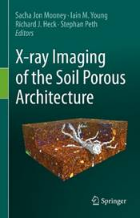
X-ray Imaging of the Soil Porous Architecture
By Editors Jon Mooney, Sacha, Young, Iain M., Heck, Richard J., Peth, Stephan, Springer International Publishing, November 2022, ISBNs 978-3-03-112175-3, 978-3-03-112176-0
Summarizes almost 40 years of research in the area of X-ray CT imaging of soils. Introduces best practices for both image acquisition and analysis. Includes detailed examinations of different software packages for X-ray CT analysis.
In December 1973 Godfrey Hounsfield published his seminal paper on transverse axial scanning, describing a methodology that could non-destructively analyse a human head (Hounsfield, 1973). Two years previously, a patient’s head had been scanned in what was the first system available to hospitals developed by Hounsfield and his research partners. Thereafter, an explosion in the use of Computed Tomography (CT) systems for medical purposes was observed in most western countries. Now scans are faster, safer and more accurate and the use of CT has extended far beyond the medical practices; and we now see CT specifically designed and used for mining, electronics, engineering and environmental challenges. This edited collection explores the use and development of CT for soil ecosystems, the most complex biomaterial on the planet, identifying best practice and new approaches to the quantification of pores, roots and organic matter, all non destructively and all in situ.
Read more: doi 10.1007/978-3-031-12176-0
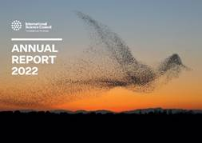
ANNUAL REPORT 2022
International Science Council (ISC)
By The International Science Council share its 2022 Annual Report, reviewing year in tackling complex global challenges through knowledge-driven solutions and the powerful global voice of science.
Read more and download: 2023-05-22-Annual-report-web.pdf (council.science)
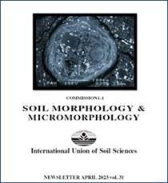
Newsletter IUSS Commission 1 Soil Morphology and Micromorphology
By In this newsletter they report the change in Commission officials. Basically Richard Heck (former VP) now presides Division 1 while Fabio Terribile and Adam Szorba will act as president and vice president respectively of our Commission for the period 2022-2026. In this issue they report the minutes of the work meeting they had at the WCSS in Glasgow where they modified the changes to the award evaluation criteria regarding the two awards (Kubiena and MYPA). In this volume: next meetings, next courses and report of previous courses, next international conference on soil micromorphology, new website.
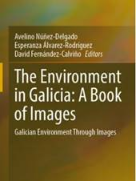
The Environment in Galicia: A Book of Images: Galician Environment Through Images
By Avelino Núñez-Delgado (Editor), Esperanza Álvarez-Rodríguez (Editor), David Fernández-Calviño (Editor); Springer International Publishing; ISBN-13 9783031331138; pages 640; publication date: 07/26/2023, https://doi.org/10.1038/s41467-023-38043-1
This book describes the environment in Galicia (NW Spain), with researchers and professors presenting their own photographs of relevant aspects. This richly illustrated book explains atmospheric, geologic, water, soils, landscapes, and environmental issues and treatments for a broad audience, including students and the general public, to raise awareness and effectively develop strategies to meet the Sustainable Development Goals.
EUSO Annual Bulletin A review of 2022 activities
By Maréchal, A; Panagos, P.; Jones, A.; Arias Navarro, C.; Ballabio, C.; Belitrandi, D.; Breure, T.; De Medici, D.; De Rosa, D.; Fendrich, A.; Koeninger, J.; Labouyrie, M., Liakos, L.; Martin Jimenez, J.; Matthews, F.; Montanarella, L.; Muntwyler, A.; Orgiazzi, A.; Scarpa , S.; Schillaci, C.; Simoes Vieira, D.; Van Eynde, E.; Van Liedekerke, M.; Wojda, P.; Yunta Mezquita, F., JRC133346 EUR 31506 EN PDF ISBN 978-92-68-03434-7 ISSN 1831-9424 doi:10.2760/501153 KJ-NA-31-506-EN-N Luxembourg: Publications Office of the European Union, 2023 © European Union, 2023
This report presents the activities of the EU Soil Observatory (EUSO) that took place during 2022. Through its five main objectives, the EUSO contributes to improving the monitoring of soils, to creating and sharing knowledge and data about EU soils, in particular producing tailored outputs in support of policy development and to the wider public. These activities feed into the overarching knowledge management objective under which the EUSO provided extensive policy support to a range of policy areas, notably the upcoming Soil Health Law and the Horizon Europe’s Soil Mission. A key element of the EU Soil Observatory are the six EUSO Working Groups (WG) that aim to discuss policy or technical advances on a particular topic. Their activities in 2022 were diverse and ranged from providing policy support (Soil Monitoring, Soil Pollution WGs), technical progress on integration of soil data (Soil Data WG) or advancing scientific knowledge about soils (Soil Erosion WG). This report also highlights the developments to be expected in 2023. In particular, the EUSO will produce reports on soil pollution, soil organic carbon trends, pesticides in soils, land degradation and a soil fertility index and work on the state of soil health in the EU. A key development will be the publication of the EUSO soil health dashboard. The EUSO will support dedicated Soil Mission research projects and will continue to provide support for the upcoming Soil Health Law proposal. The EUSO is also planning a 2023 EU Soil Week.
Download: https://esdac.jrc.ec.europa.eu/public_path//shared_folder/doc_pub/JRC133346.pdf
WASWAC HOT NEWS ISSUE 04, 2023
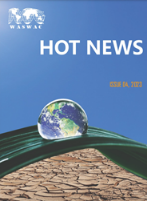
The advancement of knowledge and the future of scientific soil protection associations
By José L. Rubio Deputy president WASWAC, Co–founder and Ex-president of European Society for Soil Conservation, Ex-Director of Desertification Research Centre-CIDE, Valencia, Spain, pp. 2-15, Editor: Pengfei Du Assistant Editors: Li Li, Donghao Huang, Xiaofei Nie, Silian Pan
Read More: http://www.waswac.org.cn/waswac/LatestNews/webinfo/2023/06/1686793539589275.htm
Download: http://www.waswac.org.cn/waswac/rootfiles/2023/06/07/1686793533065162-1686793533099861.pdf
ITALIAN JOURNAL OF AGRONOMY
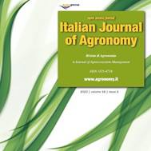
Vol. 18 No. 2 (2023): Special issue on: ‘Integrated soil-water-crop management in salt-affected areas’
Authors: Filiberto Altobelli, Anna Dalla Marta, Anna Benedetti, Maria Konyushkova, Giuseppe Corti
https://doi.org/10.4081/ija.2023.2189
https://www.agronomy.it/index.php/agro/issue/view/91
European Journal of Soil Science (EJSS)
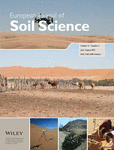
Volume 74, Issue 4 July–August 2023
Online ISSN:1365-2389
Read more: https://bsssjournals.onlinelibrary.wiley.com/journal/13652389
Soil Use and Management
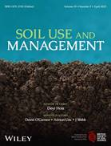
Soil Use and Management publishes in soil science, earth and environmental science, agricultural science, and engineering fields. The submitted papers should consider the underlying mechanisms governing the natural and anthropogenic processes which affect soil systems, and should inform policy makers and/or practitioners on the sustainable use and management of soil resources. Interdisciplinary studies, e.g. linking soil with climate change, biodiversity, global health, and the UN’s sustainable development goals, with strong novelty, wide implications, and unexpected outcomes are welcomed.
Online ISSN:1475-2743
Read more: https://bsssjournals.onlinelibrary.wiley.com/journal/14752743
Advertisements

WET-2 Sensor – measures moisture and nutrient content in the root zone
____________________________________________________________
● Accurate soil water content, pore EC, and temperature
● Minimal soil disturbance
● Comprehensive set of calibrations for soils and substrates
● Available in kit form with instant readout meter and case
The Delta‐T Devices WET-2 Sensor has crucial applications in soil science research and precision horticulture and is usable in both soils and growing substrates. It is exceptional in its ability to accurately measure pore water conductivity (ECp) – the EC of the water that is available to the plant.
More information on the WET-2 Sensor


IUSS Alerts are e-mailed to more than 3,000 individual subscribers and 80 national soil science societies globally. Please forward the IUSS Alerts to your friends and colleagues. Send information for IUSS Alerts to iuss.secretariat@crea.gov.it. If you wish to unsubscribe, please send an email to iuss.secretariat@crea.gov.it.
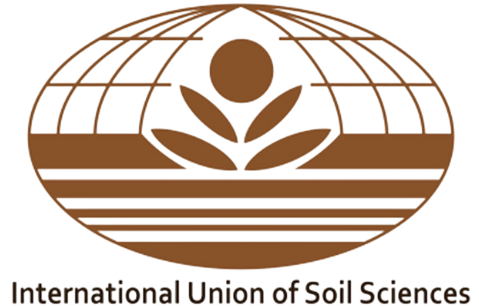


You must be logged in to post a comment.